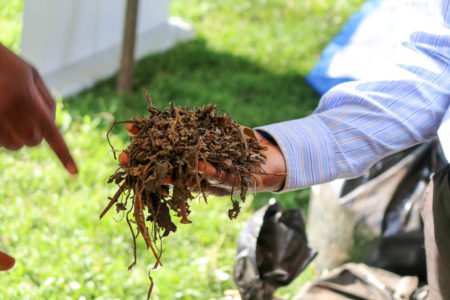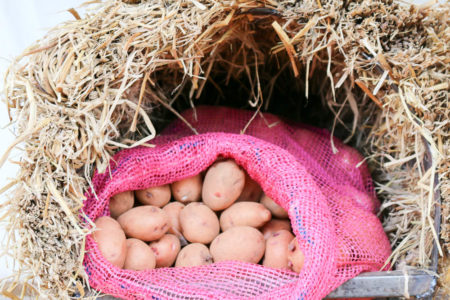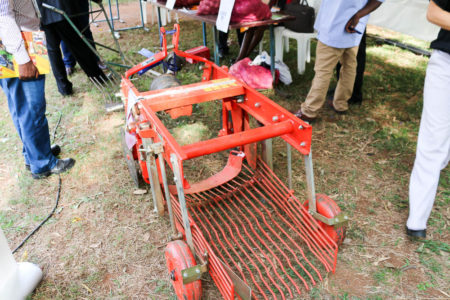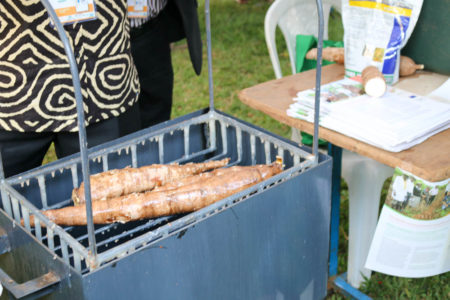
By Vivian Atakos
Key stakeholders implementing an innovative project on expanding utilization of roots, tubers and bananas and reducing their postharvest losses (RTB-ENDURE) came together for an end of project workshop to share their experiences and the main research findings. The project led by the International Potato Center comes under the umbrella of the CGIAR Research Program on Roots, Tubers and Bananas (RTB). The dissemination meeting, held on 6 and 7 December, was held in Entebbe, Uganda. A side exhibition shared progress with novel post-harvest technologies and innovations trialed for the first time with users in Uganda.
“RTB-ENDURE project developed a number of post-harvest technologies across various crops. Let’s promote them at scale”, said Yona Baguma, Deputy Director General for Research at National Agricultural Research Organization (NARO), while officially opening the workshop.
The three-year project (2014-2016) was funded by the European Union and the International Fund for Agricultural Development (IFAD) and looked at four crops: potato, sweetpotato, banana and cassava.
“We looked into varieties for specific processing and post-harvest handling, agronomic practices, harvesting technologies, processing and handling approaches and practices, value addition and needs of consumers”, noted Diego Naziri, Project Leader RTB-ENDURE who works for CIP as a Post-Harvest Specialist. “We endeavored to address the needs of an emerging middle class in Uganda demanding for higher value products, less perishability and more convenience”.
The project built on three main pillars: research to build the evidence base in terms of post-harvest management; value chain development and capacity building of researchers, students and value chain actors. It identified a number of bottlenecks in the available technologies in the postharvest management of the four project crops; coming up with possible solutions.
“The research teams developed businesses cases that looked at the technical feasibility and business case for each innovation. Each team worked with farmers and private sector operators from the beginning”, said Graham Thiele, Director of RTB.
Innovative approaches piloted

Over two to three years, better technologies aimed at expanding use and post-harvest management of RTB crops have been identified that stakeholders, especially farmers, are confident work well for them.
For sweetpotato, farmers and rural youth in Masaka and Kamuli districts in Uganda are now making pig feed out of vines and roots. The silage is used to complement other animal feeds. “This technology fits well in the pig production system. Sweetpotato silage is available when feed is scarce and is affordable to the smallholders”, said Simon Heck, Sweetpotato Program Leader at CIP. The technology had not been trialed in Uganda, hence an opportunity with huge possibilities for generating employment and revenue.
For the potato crop, CIP partnered with NARO and farmers, to introduce new varieties and clones as well as rural stores that allow farmers to keep their potatoes several months after harvest and sell when prices are high.

“We sought to address loss along the potato value chain up to the point of marketing. We introduced new potato varieties from CIP as well as clones, seeking good value for processing”, said Dr. Arthur Wasukira, a researcher with NARO. “Through farmer organizations,

we hope farmers can have access to harvesting equipment such as the tractor drawn potato lifter to reduce loss during harvesting”, he concluded.
Cassava farmers on the other hand, are embracing a new technology from south America, aimed at addressing the high perishability of the root crop. John Balinda, a private sector actor working closely with these farmers said “we have reached a point where we can successfully wax cassava, test it up to 30 days and it is still good. This combined with better agronomic practices learnt as part of this project, such as pruning and ridging, ensures farmers extend the shelf life of cassava and sell at lucrative prices”.
 |
 |
| Picture 4: Cassava waxing was on display at the exhibition section | |
Innovations on the banana crop addressed various aspects of marketing. This included weighing and packaging of peeled bananas offering consumers more convenience while ensuring farmers received better returns.
Overall, the RTB-ENDURE project used the Participatory Market Chain Approach (PMCA), a value chain development methodology developed by CIP. PMCA requires involvement of a broad range of stakeholders. The project stakeholders included five CGIAR centers—CIP, International Center for Tropical Agriculture (CIAT), Bioversity International, International Institute of Tropical Agriculture (IITA) and CIRAD — five institutes of NARO, three universities in Uganda, several Non-Governmental Organizations, and private sector including traders, processors, exporters and farmer organizations.
“We have sowed seeds for productive work going forward by bringing together all these partners. We look forward to when these great ideas set into motion will mature into businesses and opportunities, adding more value to sweetpotato, potato, cassava and bananas while translating into better fortunes for farmers”, said Thiele.
